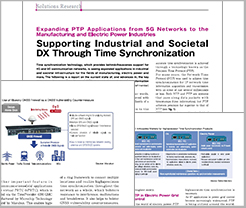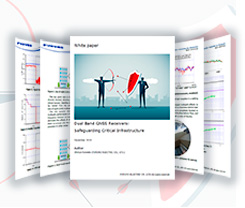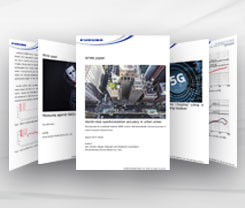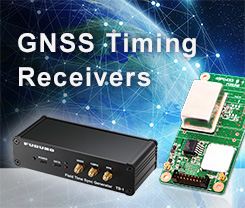Column
Common Problems That Affect GPS/GNSS Time Synchronization
GNSS receiver devices make it possible to easily acquire highly accurate time data. Today, accurate time information provided by these receivers is used in vital social infrastructure all around the world, including mobile base station and TV relay stations, seismographs, electric power grids and financial exchanges. In short, GNSS technology enables some of the nonstop services we rely upon 24 hours a day, 365 days a year. However, it suffers from some unique vulnerabilities. If you are considering the use of your own GNSS receiver, it is important to understand these vulnerabilities in order to ensure safe, reliable usage in your particular application. FURUNO ELECTRIC products harness a number of countermeasures to minimize time accuracy loss, and we provide detailed explanations via our technical white papers. The following is a general overview of both.
GNSS Vulnerabilities and Countermeasures
The vulnerabilities and conveniences of GNSS are two sides of the same coin. GNSS receivers can make use of radio waves for precise positioning and time information calculations, all made conveniently possible with the simple installation of a GNSS antenna—something that can be set up virtually anywhere, no matter where you are in the world. On the other hand, signal propagation delays are sometimes caused by tropospheric and ionospheric conditions, which reduces positioning and time accuracy. A certain degree of compensation for these types of delay can be achieved via propagation delay models. However, major error can occur due to multipath propagation in built-up urban areas where tall buildings and other structures cause signal reflection, and this must be taken into consideration during time calculations. As a result, measures to minimize multipath are an absolute necessity when it employing GNSS-based time synchronization.
In addition, antenna breakdowns and malfunctions, and the presence of proximate frequency bands from other wireless transmission systems (which produce unwanted signals), can interfere with signal receipt. In recent years, malicious use of intentional jamming signals has become a major problem, in response to which measures to mitigate jamming signal effects and (in less common cases) complete signal stoppages are necessary.
Protocols for communication technologies used between GNSS satellites and receivers are publicly available. This enables fair and open availability to anyone of GNSS services while also making it easy to create false satellite signals—known as "spoofing"—which brings about major problems by causing erroneous position and time calculations. In response, it is necessary for operators to identify spoofing signals and avoid their use in calculations.

Example of time-sync performance drops caused by GNSS system vulnerabilities
Multipath

It is a given that, in order to achieve high-accurate time synchronization using GNSS, one must install their GNSS antenna in a high-up location open to the sky. When the antenna is positioned in a location with poor reception conditions, such as among tall buildings or in narrow valleys, it may not be able to receive direct signal waves. It may also be susceptible to multipath propagation (often referred to simply as "multipath") caused by signal reflection and diffraction off of surrounding structures and surfaces. When a GNSS receiver uses multipath signals, the result will be reduced time accuracy.
In urban areas, the proliferation of the next-generation mobile communication standard 5G, the technology V2X ("vehicle-to-everything," for use between multiple vehicles and between vehicles and traffic-related systems), and other such technologies requires the installation of numerous wireless communication stations. As a result, demand is on the rise for more precise timekeeping within multipath-susceptible environments.
Signal Interruption

Interruption of satellite-signal reception following commencement of GNSS time-synchronization operations is a commonly encountered issue. A GNSS receiver utilizes signals sent from satellites to make accurate time calculations, and a signal interruption can cause major problems with system operations.
A few specific examples of signal interruption causes include GNSS antenna breakdown, severance or failure of the cable connecting the antenna with the receiver, interfering objects near the antenna blocking the signals, and reduced signal-receipt performance caused by a major solar flare event.
It is important to take advance consideration of measures against signal interruptions to ensure reliable GNSS system operations.
Interfering Signals: Jamming

The GNSS signals sent out by satellites are extremely weak, meaning that any source of interfering noise or other signals near a GNSS antenna can create jamming signals (known as "spoofing" when intentional), which inhibit the correct receipt of expected GNSS signals.
In recent years, GNSS jammers, which are devices designed for the purpose of intentionally interfering with GNSS signal waves, have become widely available on online shops. In many cases, people use these jammers to hide their position information (which is illegal). With the spread of GNSS system usage, problems caused by GNSS jamming have also been on the rise.
Signal Impersonation: Spoofing

Persons with malicious intent sometimes broadcast falsified signals—a type of signal "impersonation" known as spoofing—which may contain misleading information related to position and time. Starting in June 2017, multiple ships in the Black Sea were targeted by spoofing attacks, bringing about an increase in vigilance regarding this problem. If a GNSS receiver used for acquisition of time information receives such spoofing signals, its system may suffer harmful effects due to erroneous time calculations. In the event of a mobile network base station, for example, an attack like this may lead to major problems such as loss of communication services.
And because software-defined radios (SDRs, which are software-based radio communication devices) have become available at increasingly low prices in recent years, concerns about spoofing are growing.
Reference Materials
FURUNO ELECTRIC provides technical white papers covering the major causes of GNSS system problems outlined above.
In regard to specific causes of breakdown and system trouble, our engineers (who specialize in time-sync operations) can describe possible countermeasures on the receiving end, go over measure effectiveness, and help customers choose appropriate products, all while presenting useful charts and graphs for reference.
If you are considering the purchase of your first GNSS receiver, we hope you will take a look at the following documentation.
The download link below enables you to download five different technical white papers at once, including "High Stability 4.5ns (1 sigma) using a single band GNSS timing receiver."
- Multipath white paper:
Industry-leading multipath mitigation in urban canyon environments - Jamming (interfering waves) white paper:
Measures against GNSS jamming (jamming wave) - Spoofing ("impersonation") white paper:
Measures against GNSS spoofing signals - GNSS signal interruptions white paper:
"Holdover function" as measures against GNSS reception interruptions
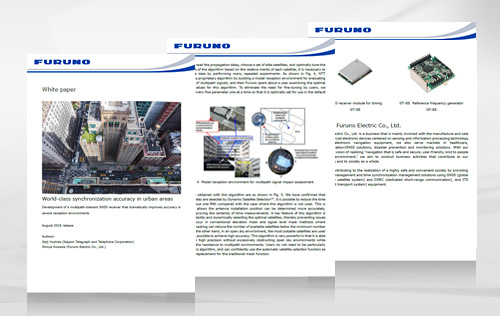
Pick up
Column
FURUNO Column
-
Common Problems That Affect GPS/GNSS Time Synchronization

-
How to select GPS/GNSS antennas for time synchronization

Column by Mr. Mitsunari Kita (Science and technology writer)
-
The Observation Network Created by the Earthquake Proves Useful for Accurate Timekeeping (Part Two of Two) - A Solution to the "Mr. Higgins Problem" in Space -

-
The Observation Network Created by the Earthquake Proves Useful for Accurate Timekeeping (Part One of Two)

-
FURUNO ELECTRIC Joins Experts From Around the World on a Norwegian Island for Jammertest 2024

-
Unraveling the Mysteries of Venus Based on "Occultation"

-
Atoms as the Basis for Measuring Both Fleeting Moments and Near-Eternities

-
Time Progressing with a Speed Difference of Just 4.4647 Ten-Billionths!

-
Critters Who Revitalize Forests Through the Spreading of Food Caches

-
Small But Significant Variances in Gravity and Time (Part Two of Two)

-
Small But Significant Variances in Gravity and Time (Part One of Two)

-
Why the GT-100 Time-synchronization GNSS Receiver Module is Like Fragrant Soup Curry

-
What Rainbows Can Teach Us About Dual-Band GNSS

-
The Amazing Things That Are Possible With Just a Clock

-
When Subterranean Earth Meets Outer Space

-
Using the TB-1 and GT-100 at a "Multipath Dojo" in the Major Metropolis of Osaka

-
The Disaster-struck Field Time Sync Generator TB-1: True Performance Revealed Through a Lightning Strike

-
Knowing the "Now" of Our Earth Through GNSS

-
The Reason GPS Counts Time in 1.5-second Intervals

-
Similarities Between "On My Count!," the 117 Notification System, and GPS

-
Reliable Clocks Help Us Find a Silver of the Clouds

-
Why Time Synchronization is Vital for Criminal Investigations, Seismograph Measurements and Solar Wind Observation

-
What Was "Cesium" About Cesium Akina?

-
Updating Analog Broadcasting with GNSS Time Synchronization Technology

-
The Long History of One Second (Part II)

-
The Long History of One Second (Part I)

-
A Solo Journey - Three-liter Microsatellite Mission Support via GPS (GNSS) and Satellite Communication -

-
A Solo Journey - The GPS (GNSS) Tracking System That Helped Kenichi Horie Cross the Pacific -

-
The Day After a Superflare - Effects on power and wireless communication infrastructures -


